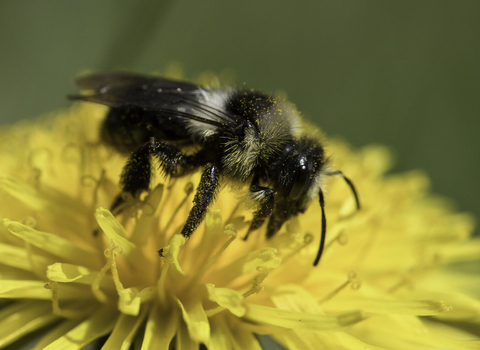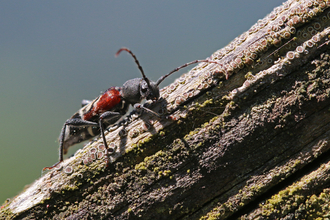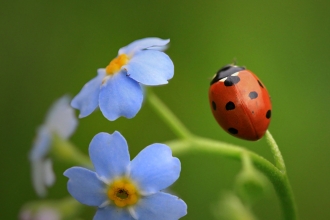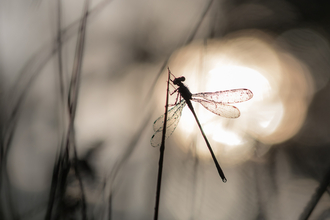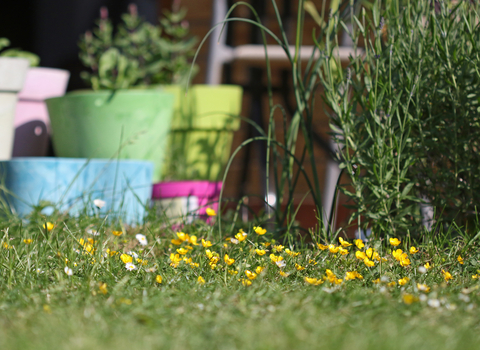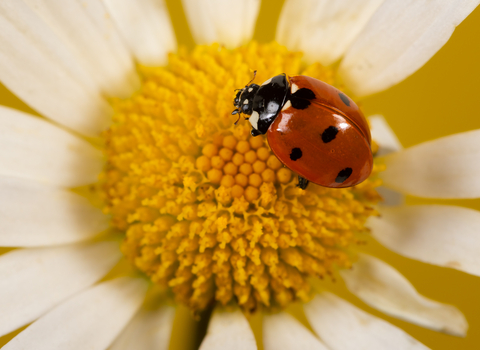You might be amazed to learn that there are more than 270 species of bee in the UK. They come in all shapes, sizes and colours and many bear little resemblance to the common image of a stripey black and yellow, fluffy insect. Our familiar bumblebees live in colonies, working together for the good of the whole. However, solitary bees are different. Wendy Carter, communications lead at Worcestershire Wildlife Trust and a big bee fan, picks out some solitary species to spot across the county.
Solitary bees live differently to other bees, with females providing food for their own offspring in nest holes in soil, wood, plant stems and even brick walls. In some bee species, sneaky females steal into other bees’ nests to lay their own eggs; their young kill the original bee’s offspring and gorge on the pollen left behind. Many can be found in your garden and local green space if you’ve got a moment to look.
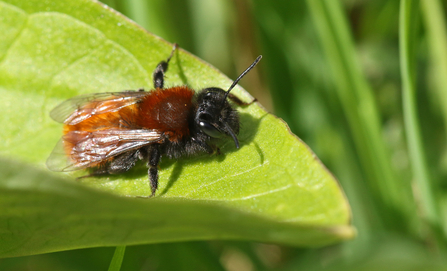
Tawny mining bee by Wendy Carter
Tawny mining bee Andrena fulva
A member of the largest group of bees in the UK, all of whom nest in the ground (from flower beds to sandy cliffs). The honeybee-sized females are one of our more distinctive bees, with a thick coat of the fox-furriest tawniest colour. To complete this ball-gown of an outfit, the females have black face and legs. Look for the smaller, less-bright males with an Einstein-like silver moustache.
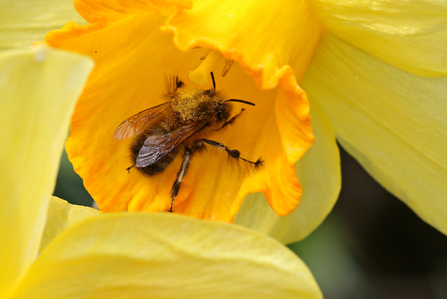
Hairy-footed flower bee by Wendy Carter
Hairy-footed flower bee Anthophora plumipes
Zoooooommmmm...zoooommm! Have you spotted a small furry insect streaking past you at a rate of knots? If you’ve got lungwort, dead nettles, rosemary or alkanet in your garden, stop and take a look (and listen). Females are black with fluffy orange-haired back legs where the pollen is trapped. Males are gingery with creamy-yellow faces and long hairs on their middle legs that give them their common name.
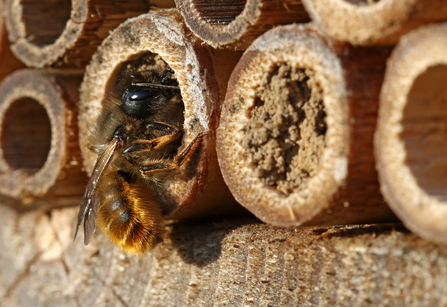
Red mason bee by Wendy Carter
Red mason bee Osmia bicornis
A common resident of bee boxes located in warm, sunny spots, red mason bees also make the most of gaps in crumbling mortar. Females construct nests from earth so look in nearby flower beds and plant pots after its rained to spot them gathering mud between the two small ‘horns’ on their face. If a bee in a cell at the back of the nest wakes first, it chews through the wall and bites the bottom of the bee in front to wake it up!
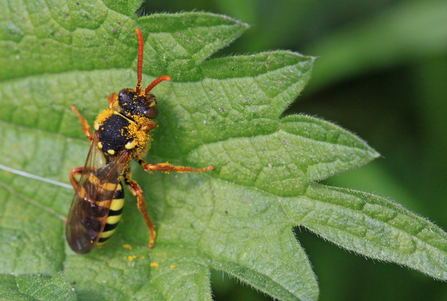
Gooden's nomad bee by Wendy Carter
Gooden’s nomad bee Nomada goodeniana
Mostly hairless and often boldy marked, this genus of bees is often mistaken for wasps. You may spot a Gooden’s nomad bee covered in pollen after foraging in dandelions or umbellifers. Their bold black and yellow pattern can help you find the nests of other bees. Females lie in wait, aiming to locate mining bee nests – when the coast is clear, they nip in to lay their own egg, just like a cuckoo!
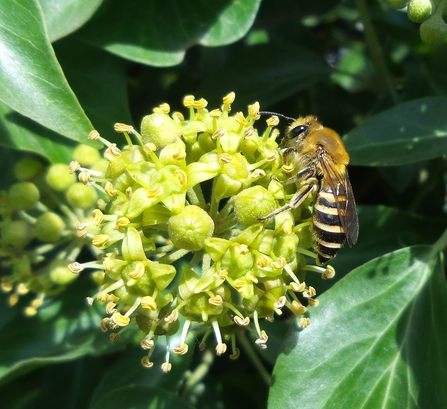
Ivy bee by Gary Farmer
Ivy bee Colletes hederae
This late season mining bee has only been in Worcestershire since 2013 and gets its common name because females gather only ivy pollen to provide food for their young. Nesting aggregations, often in lawns or flower beds, can number in the thousands. There’s no need to panic, though. Like all bees, it’s only the females that sting and the sting of solitary bees is usually too weak to pierce our skin.
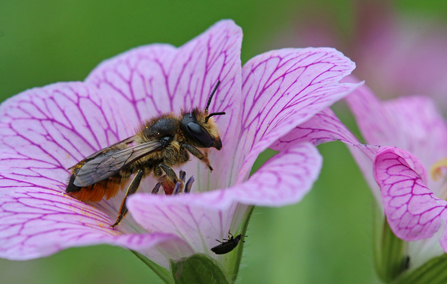
Patchwork leafcutter bee by Wendy Carter
Patchwork leafcutter Megachile centuncularis
Ever spotted semi-circles missing from your rose leaves? Enter our leafcutter bees. Sit by a bee hotel for long enough and you may be lucky enough to spot a female patchwork leafcutter bringing home a leaf to line her nest cells with. Look closely and you’ll see that, like red mason bees, these brown medium-sized bees have a ‘brush’ under their abdomen to collect pollen.
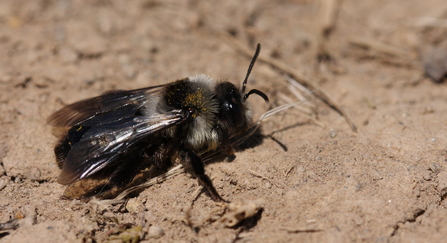
Ashy mining bee © Vaughn Matthews
Ashy mining Andrena cineraria
A very distinctive bee that is one of the first to emerge in spring. As with many solitary bees, the female is larger and more conspicuous, although both sexes have silver-grey hairs on the thorax and face along with a shiny blue-black abdomen. Look for their mini-molehill nests in lawns, short turf and bare ground; sometimes they can be found in very large aggregations.
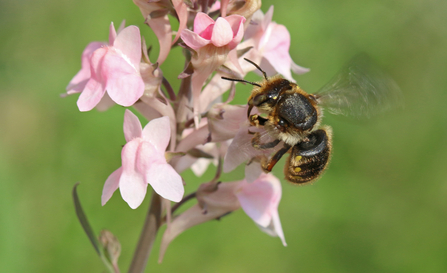
Wool carder bee by Wendy Carter
Wool carder bee Anthidium manicatum
Lamb’s-ear (Stachys) and woundwort are favourites of this distinctive species with yellow spots on the edge of the abdomen. The name derives from the females’ ability to card fibres from woolly or fluffy plants to use in nests. Unusually, males are bigger than females and have spines at the end of their abdomen that they use to protect both territories and females!
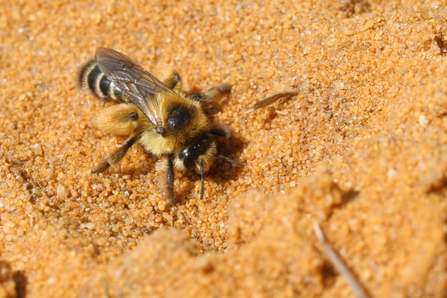
Pantaloon bee by Margaret Holland
Pantaloon bee Dasypoda hirtipes
The star of Worcestershire’s heathlands; with the eponymous pantaloon-like pollen brushes decorating the back legs of the female, this is a bee that’s hard to misidentify. They nest in sandy south-facing slopes and along paths. From midsummer, look for them foraging in yellow flowers like cat’s-ear, hawkbits and ox-tongues.

